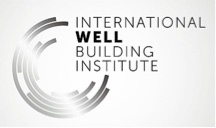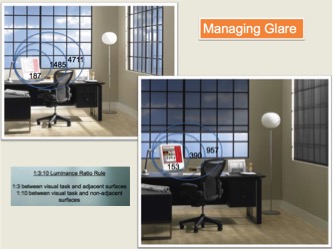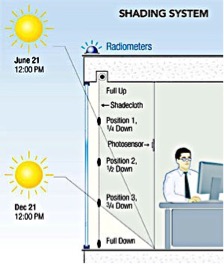Green building trends and organizations have made significant achievements in setting standards for more sustainable solutions by utilizing interior solar shades and exterior solar shades. Most of these gains have focused on energy and water conservation, recycled materials and environmentally conscious building practices. During this time little has been done to create strategies to improve the health and well being of how the occupants of these building fare. Things are changing with rapid pace on a significant scale.
The WELL Building Standard is leading this charge into improving the health and wellness of building occupants. The company Delos is the creator of the WELL Building Standard (WELL).
The Delos website describes WELL as the world’s first building standard focused exclusively on human health and wellness. It marries best practices in design and construction with evidence-based medical and scientific research – harnessing the built environment as a vehicle to support human health and wellbeing. WELL is grounded in a body of medical research that explores the connection between the buildings where we spend more than 90 percent of our time, and the health and wellness impacts on us as occupants. The WELL Building Standard is the culmination of seven years of research, in partnership with leading scientists, doctors, architects and wellness thought leaders.
WELL identifies 100 performance metrics, design strategies, and policies that can be implemented by the owners, designers, engineers, contractors, users and operators of a building.
It is based on a thorough review of the existing research on the effects of spaces on individuals and has been advanced through a thorough scientific and technical review.
In order to achieve the requirements of the WELL Building Standard, the space must undergo a process that includes an on-site assessment and performance testing by a third party
The Seven Concepts of the WELL Building Standard
The WELL Building Standard sets performance requirements in seven categories relevant to occupant health in the built environment – Air, Water, Nourishment, Light, Fitness, Comfort and Mind.
Air: Optimize and achieve indoor air quality. Strategies include removal of airborne contaminants, prevention and purification.
Water: Optimize water quality while promoting accessibility. Strategies include removal of contaminants through filtration and treatment, and strategic placement.
Nourishment: Encourage healthy eating habits by providing occupants with healthier food choices, behavioral cues, and knowledge about nutrient quality.
Light: Minimize disruption to the body’s circadian rhythm. Requirements for window performance and design, light output and lighting controls, and task-appropriate illumination levels are included to improve energy, mood and productivity.
Fitness: Utilize building design technologies and knowledge-based strategies to encourage physical activity. Requirements are designed to provide numerous opportunities for activity and exertion, enabling occupants to accommodate fitness regimens within their daily schedule.
Comfort: Create an indoor environment that is distraction-free, productive, and soothing. Solutions include design standards and recommendations, thermal and acoustic controllability, and policy implementation covering acoustic and thermal parameters that are known sources of discomfort.
Mind: Support mental and emotional health, providing the occupant with regular feedback and knowledge about their environment through design elements, relaxation spaces, and state-of-the-art technology.
Window Shading Solutions
Window Shading Solutions play a significant part for a building to achieve silver, gold or platinum WELL certification. The WELL Building Standard includes two areas under the Light concept where shading solutions play a role: Solar Glare Control and Automated Shading and Dimming Control.
SOLAR GLARE CONTROL
Glare is caused by a significant ratio of luminance between the visual task and the glare source. A solar shade will reduce the disparity in light levels as in between a computer screen and a window.
To understand the cause of glare, let’s take a look at the 1-3-10 Luminance Ratio Rule, which states that the ratio of light levels between the visual task and an adjacent surface needs to be less then 1 to 3, and that the light level between a visual task and a non-adjacent surface should fall within a 1-to-10 ratio.
In the photo below, the room without an interior shading solution, the light levels fall way beyond the 1-3-10 Luminance Ratio Rule, and the result is glare. However, with glare-reducing fabrics, the levels are corrected, which reduces the glare by as much as 95 percent.

WELL Building Standard for Solar Glare Control:
At least one of the following is present for all glazing less than 7 ft. above the floor
1) Interior window shading or blinds that are controllable by the occupants or set on a timer.
2) External shading systems that are controllable by the occupants or set on a timer.
3) Variable opacity glazing, such as electro-chromic glass, which can reduce transmissivity by 90% or more.
AUTOMATED SHADING
Automated shading control for the WELL Building Standard suggests shading control systems that will adjust the level of the shades to protect the occupants’ from excessive glare without disrupting occupants from other tasks. The Somfy Animeo system will adjust and maintain the solar shade height to limit the distance that sunlight enters the space. This results in the ability to protect furnishings, maximize daylight availability and minimize glare on work surfaces and computer screens.
 The Somfy Animeo can also be programed for real and astronomic timed events. With Animeo Timed Events feature, schedules can be created to keep buildings energy efficient based on certain times of day. Creating timed events around periods of high occupancy (between
The Somfy Animeo can also be programed for real and astronomic timed events. With Animeo Timed Events feature, schedules can be created to keep buildings energy efficient based on certain times of day. Creating timed events around periods of high occupancy (between
8:00AM and 6:00PM, Monday through Friday) and low occupancy (weekends, holidays) ensures the building is running as efficiently as possible.
WELL Building Standard for AUTOMATED SUNLIGHT CONTROL:
All windows larger than 6 ft² have the following:
Shading devices that automatically engage when light sensors indicate that sunlight could contribute to glare at workstations.
A WELL Accredited Professional (AP) will provide complete detailed information on how window shading plays a role in achieving the various levels of certification. To learn more about the International WELL Building Institute visit their website: www.wellcertified.com
{{cta(‘ab5bb3dd-773c-4050-8381-b32aefdf2821’)}}
